 I must admit it’s hard to avoid to ask “what the hell is this?” for most of the pictures you sent. But I’ll try. What the hell is this sort of robot made with (I suppose) effects? I was really fascinated by the ‘gadgets‘ on your website, especially “The Exterminator” and “Ideal Husband Ideal Wife” (!) that is described as “Mr and Mrs Ayers demonstrate how a simple electronic device can enhance marital bliss”. Does all this stuff work?
I must admit it’s hard to avoid to ask “what the hell is this?” for most of the pictures you sent. But I’ll try. What the hell is this sort of robot made with (I suppose) effects? I was really fascinated by the ‘gadgets‘ on your website, especially “The Exterminator” and “Ideal Husband Ideal Wife” (!) that is described as “Mr and Mrs Ayers demonstrate how a simple electronic device can enhance marital bliss”. Does all this stuff work?
Yes, all this stuff works, so I don’t have to!
The Robot takes a lot of batteries to run. It looks very busy, consumes a great deal of energy, and produces nothing of any value.
“All this stuff works, so I don’t have to!”: so you mean that you make a living out of your musical and artistic activity, maybe selling those devices also?
No, I didn’t mean that! I was being ironic about the false promises made for technology. At the moment, I do a part time job to pay living expenses, and the art and music activity pays for itself. The job frees me up from being too concerned about the business side of art & music, which used to take up so much time and was sometimes a real struggle. It keeps me in balance with what some people call the “real” world. I meet a lot of people who I probably wouldn’t meet through art or music. It gives me a different perspective.
At the moment, these are not for sale. I use them sometimes in installations and live performances. File under research and development.
I treat my making of devices and other artistic or musical output as an anti-career. I’m investigating relationships with technology and how technology shapes consciousness. This is a very serious artistic concern that I pursue – while retaining an amazing level-headedness and lack of pretension.
I see two other very interesting photos with quite incredible gear. Can you please describe them?
Yes, it’s incredible gear and I made it all myself. I will warn you, in constructing these machines I am consciously utilising dubious and absurd theoretical structures. The machines aren’t designed as utilitarian objects. I allow inventive improvisation to take over. They are channels for the imagination, and function as physical models of ideas and processes.
The white boxes are sound generators and sequencers based on the logic chips used in early computers. The green-topped box is an analogue synth, the black box contains a set of finger cymbals (like belly dancers use), those are beaten by a set of solenoids. They can be run by a computer, or other instruments through a built in MIDI interface. Then there are a couple of 16 step sequencers that can be used to switch electronic elements on and off in a programmed pattern. The Santon synth has a sample dish and rubbing plate which can be used in radionic medical diagnostics and distance healing. (Radionics is a questionable medical practice, which combines elements of spiritualism and divination with scientific-looking apparatus).
Behind the cymbal machine on the left is a simple rune generator, which generates a rapidly flashing display of rune characters, which is designed to disarm, entrance, and destroy neo-fascists who are attracted to that kind of thing. There are three propaganda modules and a Space Cornish communicator. These all use artificially generated human and animal voices helpful in communicating with non-human life forms.
Records: in one shot I see CDs like Hawkwind, Zoviet France:, Amàlia Rodrigues (I really like her!), Cranioclast (I love that one, “Iconoclastar”, a masterpiece for me), “Protest Songs”, “The Naxos Book of Carols”… even Nocturnal Emissions. Something makes me think that they come from different ‘directions’, maybe? I’m sure you’re a multi-faceted and multi-dimensional man, but how are the layers interconnected in terms of musical listenings?
Good question. I don’t think I’ve sampled anything off a record since “collateral salvage” where I sampled more than I could ever keep track of. So I guess these boxes reflect my musical habits.
Cranioclast: I have had since it came out, I think I must have been in contact with the group, I hung onto it because they aren’t well known and like you say it’s a great one. Amalia Rodriguez: my mother brought it me back from a Portugal holiday, and the Naxos one I probably played it over Xmas.
I found Soviet France in a charity shop in Bristol last year for 50p. I had a load of their records when I used to collaborate with them, but having had a precarious lifestyle has meant I don’t have them any more. “Protest Songs” are some great American songs from the struggles of the 20th century. It’s a great leftist old school folkie comp – we need more protest songs! There’s Clive Palmer in there, who was a founder member of the Incredible String Band, he is recorded in a tiny folk club in Cornwall.
What is in these boxes is eclectic and not at all analytic. I guess there’s a pattern to it, I’m sure. You won’t find any heavy metal. I don’t necessarily collect music for sampling, but I’m sure what I have in there informs what I do.
Mostly I keep CDs, records and tapes in alphabetical order by artist, but what you have there is an unsorted box of CDs I have brought in from the car, and some that would be kicking around the house if I hadn’t put them in the box. It’s an eclectic selection. Ten, twenty, thirty, forty years ago, I might have sampled some of these and repurposed them in some way, sometimes I’d use thousands of tiny samples on a record.
But in the way I’ve been working in recent years, my music is more built-from-scratch and maybe more precisely personal. And takes a lot longer! The way my music has evolved – it’s the method that suits me at the moment.
For the most part I wouldn’t call them necessarily “for listening pleasure”, they’re somewhere between pleasure and audio research, I gather them to inform my soundmaking. I feel I can listen better to a CD than I can to something on the radio or on the internet (I noticed the sound of MP3s really irritates me, especially when put through PA systems) and the fact of it being in a packaged physical form frames it in some sort of real life context. I guess I just absorb this diverse material and then do what I do.
I love the pic on the stairs, where I can distinguish a Gilbert & George poster, a Cornwall one, and most of all Pussy Riot and Maradona wearing the “War Criminal” t-shirt. You’ve always been ‘active’ in some political way, since the beginning of your career as Nocturnal Emissions, and this was one of the aspects that attracted me into your poetry, somehow different from the ones in the so-called ‘industrial’ area (I know you didn’t really feel part of it, right?).
It’s a bit of an art gallery staircase. A good proportion of the art was collected by my wife, Lesley. That Pussy Riot poster they signed for us when they were in Cornwall. Gilbert & George is signed too, but I never met them. You won’t be able to make it out – there’s a beer mat painting by Doc Shiels, who created some of the classic Loch Ness Monster photos, a Gen Ken Montgomery collage, a few watercolours by Artist Taxi Driver, and then there’s pieces by friends and fleamarket outsider art and an etching & a litho by Jan & Eva Svankmajer.
People like to put music into genres, and it’s largely beyond my control what genre I’ve been bundled in with.
Over time, it became very clear to me just how far up their own arses most of the industrial crowd were. They just wanted to be pop stars or something. And that uncritical industrial underground scene also provided a safe haven for obnoxious and violent narcissists who nobody with any sense would want to be associated with.
On the other hand, the very most industrial of industrial music I can think of is Test Dept, who I have no problem with at all.
You also sent me a picture of books, mostly ‘art books’.
Yes, it’s good to have books. Who needs experience, when you can have books? Why learn from your mistakes, when you can learn from other people’s mistakes? It’s great to be able to have records, tapes, CDs. It informs and feeds my creative practice. You can’t get all your information off the internet, and besides that, the internet is very badly curated.
Ok, talking about art and writings, or media in general, I understand you don’t feel associated with any specific musical genre, but there’s any artistic current that stimulates you in particular?
I suppose I could draw a Venn diagram that would associate me with some musical genres and exclude me from others?
But – as far as stimulation – I do what the spirit moves me to do.
In that sense I could be described as an outsider artist – (more accurately I’m an autonomous multi-discipline postmodern artist, but that’s a bit of a mouthful). I have tended to operate outside of artistic currents and tend to find my own path, remaining aware of, but not attached to, what is going on elsewhere.
Often I feel I am working in the tradition of dada and surrealism – as that utopian current filtered through Situationism and the late 20th century counter culture and conceptual art.
Art historically, I think “industrial music”, or “industrial culture” could be seen as a sub-category within the dada/surrealist tradition. Obviously there are both philosophical and commercial strands to that current.
In the photo with the books, and in the one with the whole studio, I see whiteboard: who wrote – and why – “I don’t give a fuck” on it?
I wrote it, it’s a motivational message, reminding myself not to overthink and get myself in balance. It’s not a rule to live by – too many people don’t give a fuck about anything apart from their own status, and the world is a mess as a result. But I was making the mistake of trying to solve climate change, poverty, war, terrorism, hypercapitalism, species extinction, death, Brexit, imperialism, torture, slavery, load of personal and family problems – and finding myself overwhelmed – obviously I wasn’t going to solve all those problems. I reasoned that I live pretty ethically, I’ve been vegetarian since I was 15, didn’t drive a car until I was over 40, I haven’t added any more humans to the world’s population, I’m kind to animals of all shapes, sizes and species, and I’m not constantly updating technology. I use aeroplanes less frequently than a lot of people I know. Perhaps I over-consume in terms of collecting things, but I tend to look after the things I have and only buy things that I know will last.
But how has your ‘activist’ attitude changed over time? You really never gave up! How can you keep fighting ‘your way’? If I look at your face, or at some other stuff in the house, you look like the most quiet of the men (so maybe that’s why you fight against the less quiet ones).
I am pretty quiet. I don’t know – I don’t really fight and I’m not the most active of activists, but sometimes the spirit might move me. I try to stay alive and awake and to pay attention to what happens in the world.
Ok Quiet man: I see three cosy, quiet little houses protected by boxes of plexiglass.
They are accurate 33 1/3 scale models I made of some of the places I have lived in and recorded my music in – part of an autobiographical project that I ’m slowly working on,
The scale, of course, relates to the revolutions per minute of a vinyl record. One of the houses is the place I live now. It is cosy, but it’s not a quiet little house, it’s right next to a busy road.
Sometimes we have to wear hearing protection if we want to relax in the garden.
I have tended to live in usually old, modest, small-scale workers’ houses, pretty much like the cottage I was born in. Never in high rise and rarely in anywhere newly built. Also I have tended to create my music in small domestic spaces, though of course I sometimes perform it in large venues. Before the home recording boom took off with personal computers, I took the creative decision to record in small domestic spaces rather than in “proper” recording studios where people are hired to do a job. I am very hands-on.
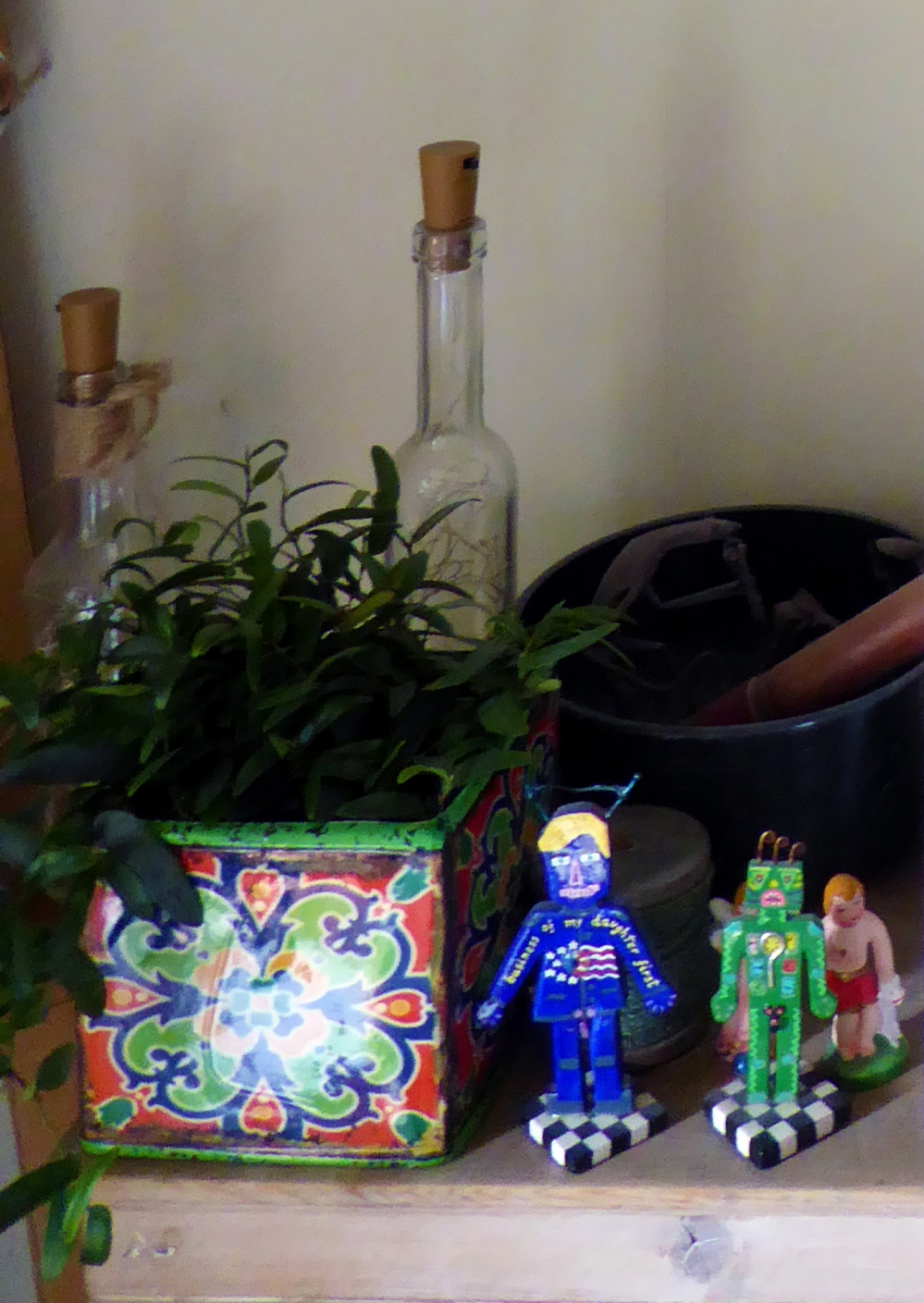
And what are the puppets at the bottom? I also discern two angels at the back…
The small figures are robot figurines of “Donald Trump” and “Vegetarian” made by a Portuguese artist called Eme. The angels are cake decorations, I think. I picked them up in a tourist shop.

What about the nice painting on the wall marked “dancing”?
The “dancing” hares are another watercolour by Mark McGowan (aka artist Taxi Driver). He also does some quite challenging political performance art. This series of his paintings tend to be protests against the destruction of wildlife, using the kind of sweet anthropomorphism you get in greetings cards.
The little houses and this painting somehow remind me of David Tibet’s paintings, another artist that I see strongly connected to some mental image I have, from abroad, of ‘Good Old England’.
That’s interesting. I guess you might get that sort of impression, from abroad. I used to know David Tibet, in the 80s when he wrote for Sounds magazine – our social networks overlapped, but I have to say his aesthetic was never really to my taste.
Yes, nationhood is definitely an imaginary construct. I have no wish to add to the propaganda of the “Merrie England” nation state, I hate the idea – male privilege, a rigid class system, an undercurrent of sado-masochism, racism, hunting, shooting, fishing, and nostalgia for Empire. Fuck that!
In Good Old England, life was very very tough for ordinary working class people.
But you mentioned many times Cornwall in the conversation, and the ones represented in the models seems (to me) sort of typical British cute houses. Do you feel strongly related to that region of Britain?
This isn’t where I grew up, but I used to come down this way for holidays and I always felt a connection. I always felt safer here. Where I grew up was in an area towards the north of England where there was a constant danger of being beaten up, just for looking a little bit different. Cornwall could do with being more ethnically diverse, but I feel far more supported and tolerated in this part of the world and this is the place I have lived the longest.
Close to each others are a folder marked “Bodmin Moor Zodiac”. Can you tell me about that Zodiac? It’s fascinating, I never heard about if unless I check recently your website…
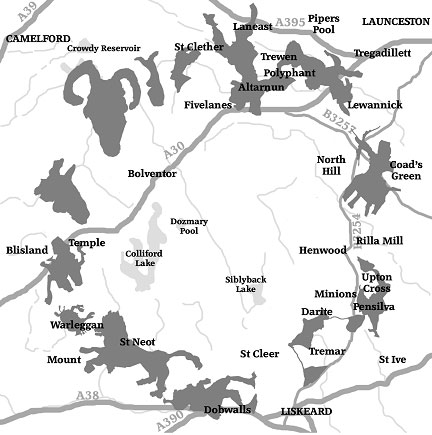 The Bodmin Moor Zodiac is an enormous map of constellation images formed by the features of the landscape, such as lanes, rivers, hedges and walls, quite close to where I live. I wrote a book about it a few years ago. It was little known when I started my researches, but it has since become better known in occult and folklore circles.
The Bodmin Moor Zodiac is an enormous map of constellation images formed by the features of the landscape, such as lanes, rivers, hedges and walls, quite close to where I live. I wrote a book about it a few years ago. It was little known when I started my researches, but it has since become better known in occult and folklore circles.
It still isn’t quite clear whether the Bodmin Moor Zodiac is an actual archaeological feature or not, and I always thought astrology was nonsense, but that didn’t stop me from spending several years researching and doing pioneering GPS field work on this supposedly haunted landscape and writing a book about it. I was largely informed by the theories of some post war French intellectuals who are supposed to have invented punk rock. I tracked down a letter where the writer TC Lethbridge had written about the Bodmin Moor Zodiac in the 1960s, around the time these Paris punk rockers were pogoing and spitting on each other as part of their traditional May riots. Also, since I did my fieldwork, the UK Highways Agency has actually created a huge new landscape feature to enhance the huge Virgo / goddess image I had mapped out – an artificial Neolithic burial site, “The Virgin’s Nipple”.
Nice! I will explore deeper. Beside it there’s a book “Arduino for Musicians”and you said that you are not “constantly updating technology”. I guess you are into the DIY Arduino movement, right?
Yes! The Arduino inventors have a great punk ethos for technology: “Don’t let the experts in one field tell you you will never be one of them. Ignore them and surprise them.” – Good advice
It’s also funny to see “How to play guitar step by step”, probably also Eric Clapton has the same book…
If you want to play guitar the hard way, get that book – all the diagrams are upside down!
All of us guitar heroes had to start somewhere. Didn’t Eric Clapton learn from Bert Weedon’s book “Play in a Day”? A lot of British guitarists of his generation did, it was all that was available.
I guess it’s obvious that I made things up as I went along. But I can’t claim I’m a total naïf. I’m not one of those guys who says “I never read the manual”. I’m the one who says “I read the manual – sometimes”. I like to know both the proper and the improper way to do things. I like it that there is so much guitar – and other learning resources out there nowadays, there never used to be anything like that when I was a child.
But I’d also tell people – you don’t have to learn anything to do art or music. You learn by doing them. They are the most natural things to do in the world! Babies sing and I’ve been painting, drawing, making things, and grooving on nature, since I was a toddler. Don’t ever grow out of it and don’t let grown ups put you off! If you’ve grown out of it, get back into it, it will keep you alive forever! The Stone Age people who painted those caves knew that.
Nigel Ayers is a multi-undisciplined artist and decomposer. He has a BA (Hons) in Fine Art Sculpture, and a MA degree in Interactive Art and Design. He formed the post-genre band, Nocturnal Emissions in 1980, which he continues to this day. Records, CDs, books, and downloads are all available. He lives in Cornwall, UK
www.nigelayers.com | www.earthlydelights.co.uk | https://nocturnalemissions.bandcamp.com/







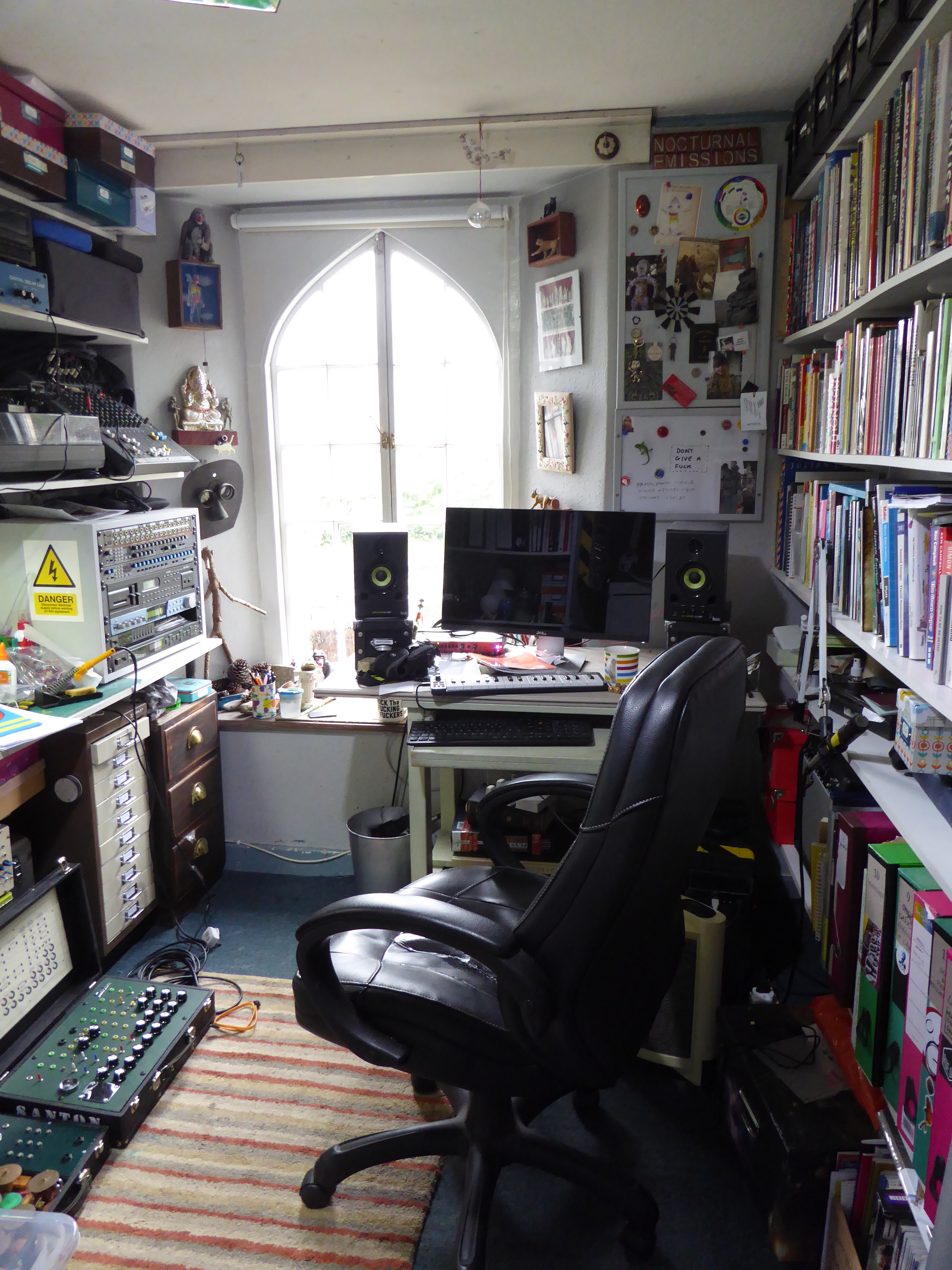
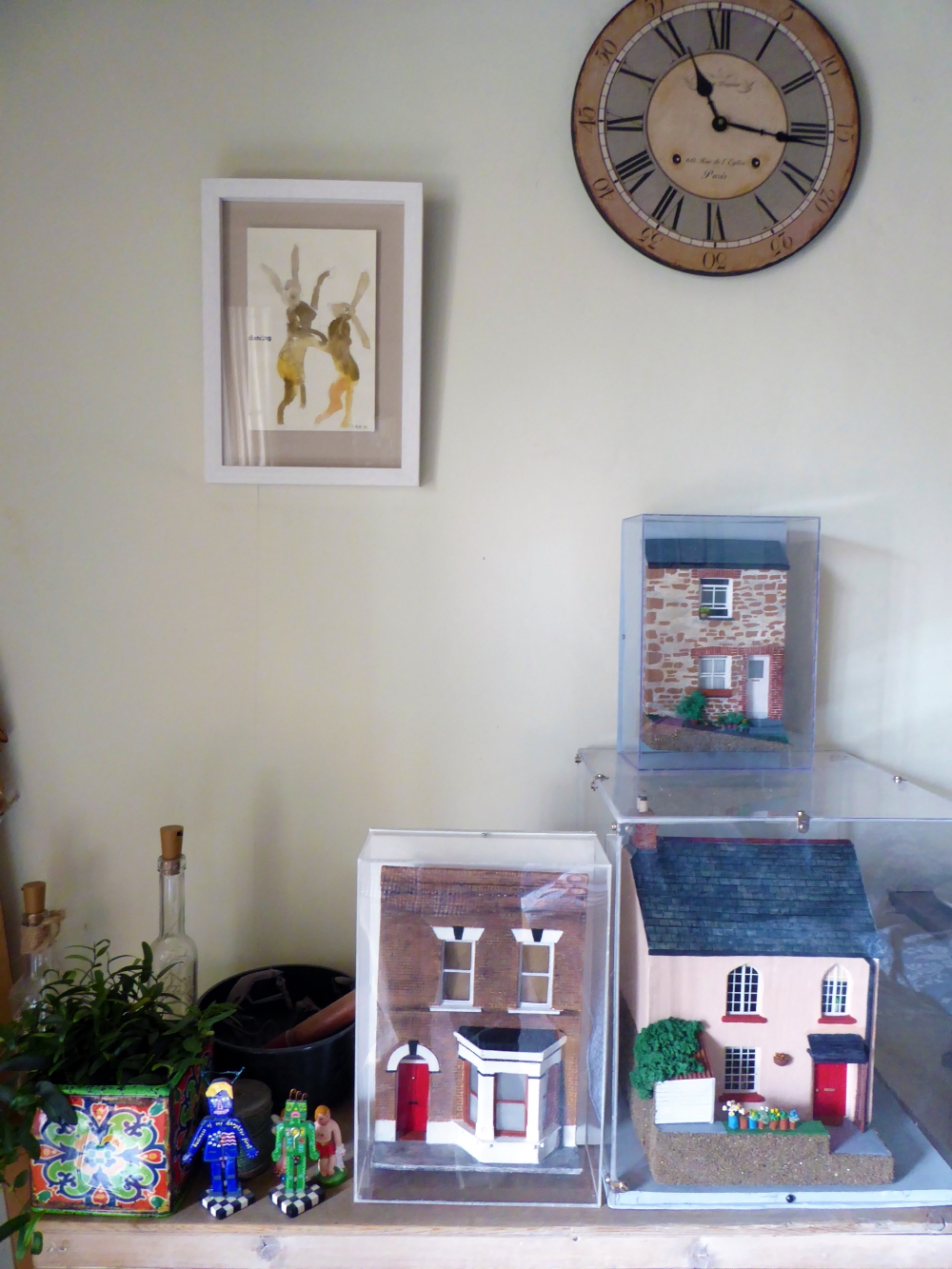
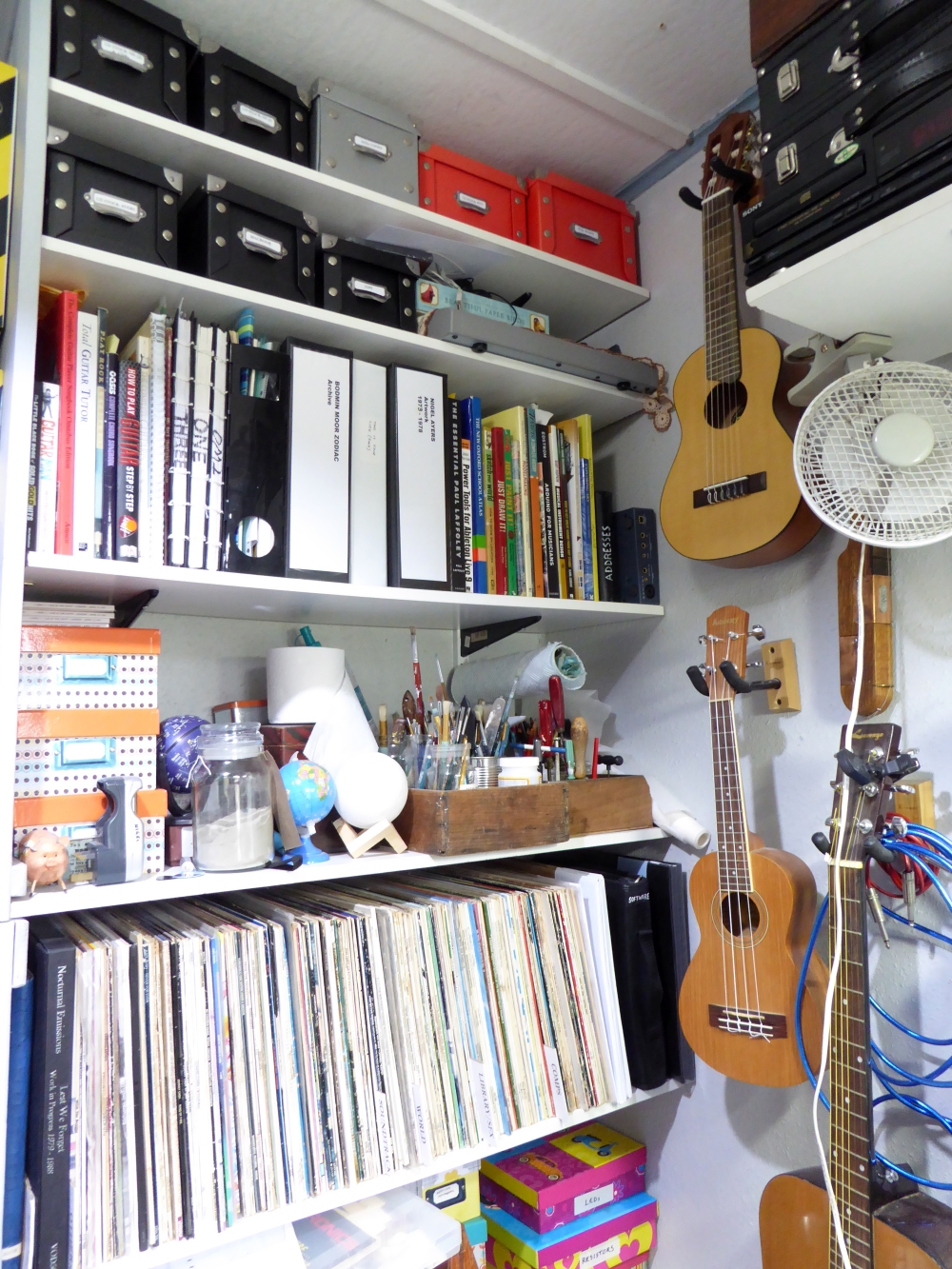




Hey Matteo – how’s it going? I wrote when you first went into lockdown in Milano – mayb3 I wen5 into your spam? . We have been locked down since. We’ve been fine here. It must be harder with kids..It might go crazy in Cornwall this weekend… at last I got this finished!
https://nocturnalemissions.bandcamp.com/album/in-dub-volume-2
Xxx
LikeLike